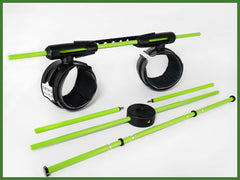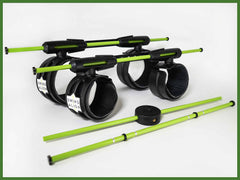How to Stop Hooking the Ball in Golf
Hooks are never fun. Whether it is a quick and low snap off the tee or it sweeps across the green into a bunker, a hooked shot costs you strokes. This article will help you learn what goes wrong in the golf swing to cause a hook, what you need to address if you find yourself hitting hook after hook, and what to do if you actually want to hit a hook.
- What is a Hook in Golf?
- What Causes Hooking?
- How to Fix Your Golf Hook
- How to Intentionally Hook a Golf Ball
What is a Hook in Golf?
A hook in golf is a ball flight that goes sharply from right-to-left for right-handed players and left-to-right for left-handers. Hooks follow the same flight as a draw but have more lateral movement. They can be hit with any club, but you will see your most drastic hooks with your driver, fairway wood, and hybrids.
Whether you hit a hook off-the-tee or approaching a green, unintentional hooks are a big problem because the ball ends away from the intended target, usually in trouble and sometimes out of bounds. Hooks usually happen if your tempo or swing breaks down, but there are times when a hook is a useful shot to escape trouble.
What Causes A Hook In Golf?
Hooking in golf comes from a closed clubface relative to your path at impact which can be caused by a strong grip, lack of body rotation or poor connection/timing between the arms and body. The most common hook comes from the challenge of getting the face square at impact. Many players flip their arms or try to turn their hands over trying to square the face. The worst kind of hooked shot comes from an outside-to-in path with a shut face and results in a pull hook which starts left and goes left. Ouch!
First we’ll talk about the clubface. A straight clubface relative to the swing path will result in a straight ball, a closed face will start the ball left of the target line, and an open face will start the ball right of the target line. If the clubface is closed relative to the club path the ball always starts and moves left of where you are aimed. The best way to square your clubface relative to the target line is to use your body to rotate the club square versus trying to manipulate it with your hands. Swing Align is an excellent device to help you rotate and keep your arms in sync with your body.
If a player’s grip is too strong, meaning their bottom hand is rotated too far underneath the club, they will likely flip or turn the clubface shut at impact. This closes the clubface too quickly or easily and results in a hook.
Fix Your Golf Hook with Swing Align!
Whatever is causing your hook, there are steps you can take to fix it.
1. Step 1 - Find the Proper Grip and Setup
While every golfer’s grip is different, it is important to make sure that yours isn’t too strong, as that may be causing you to hit a hook. Grip the club so that your top thumb is slightly right of the top of the shaft. Place your bottom hand on the club sliding your top thumb into the crease of your lower hand with the thumb of your lower hand just slightly left of the top of the shaft. If your bottom hand is rotated too far underneath the club, your grip is too strong which encourages a hook. Fix this by turning it more on top of the club, toward the target. Check this by cocking your wrists up so that you can see the V formed by your thumb and forefinger on your bottom hand. This V should point at your trail shoulder. This helps you find a more neutral hand position and will keep the face stable and square through impact.
With the proper grip, make sure that your shoulders are also properly aligned to the target using Swing Align. Swing Align will let you instantly see if your shoulders are parallel to the target or if your body is closed or open. If your body is aimed right of your target line it is closed which also encourages a hook. The combination of a closed body and strong grip is a sure-fire way to hit a quick hook!

2. Step 2 - Square the face at impact
The reason a strong grip causes hooks is because it closes the clubface at impact. That said, it is still possible to hit a hook even if your grip is not too strong.
The first step in squaring the clubface at impact is to understand what a square face looks like when you set up to the ball. If you put an alignment rod like the Swing Align Swing Junction at your feet, the leading edge of the clubface should be perpendicular to it at impact. If the toe of the club is shut at set up, or shuts too early (i.e. the toe of the club is ahead of the heel) the ball will hook.
Work on developing a consistent set up with a square face. Then work on making well connected swings where your arms and body work together to rotate the clubface square at impact. Do not flip your arms or hands at the ball to square the face. Practice making swings so that you can feel the clubface square to the ball and perpendicular to the target line shown by your Swing Junction or an alignment rod. Start with shorter swings and partial shots, working your way up to full swings. Try hitting some shots purposefully closing or opening the clubface at impact to help you feel shots where the clubface is not square. Then come back to controlled shots with a square clubface.

How to Intentionally Hook a Golf Ball
Unless you are a highly skilled player, Trying to play a hook as your standard shot is a dangerous strategy as it brings big misses into play. However, there are often times where it would be advantageous to play a hook. The most likely of which being that you find yourself stuck squarely behind a tree but have the room to play a full shot around it.
To hit a hook, you’re going to do the opposite of everything you learned above.
1. Step 1 - Strengthen Your Grip
A hook is easier to hit with a strong grip. This helps the clubface rotate through at impact and shut down as it approaches the ball. Rotate your bottom hand (right hand for righties, left hand for lefties) underneath the grip and rotate your top hand to be more on top of the club. As you make slow practice swings you’ll be able to feel the clubhead shut when you approach the ball.

2. Step 2 - Close Your Stance
Closing your stance is another easy way to help setup for a hook. To do this, drop your trail foot (right foot for right-handers, left for left-handers) back off the golf ball about four to six inches.. Your shoulders will be closed to your end target encouraging an inside-to-out swing path that will help hook the ball.
Using the Swing Align Trainer and Swing Junction, you will instantly know if you are aligned correctly to hit a hook. Right-handed players’ shoulders should align right of the end target. Remember your initial target line is right because you are curving the ball back to the left by hitting a hook. Learning to hit an intentional hook to escape trouble will impress your golfing friends!

3. Step 3 - Swing Inside-to-Out
As detailed above, a closed stance encourages the player to swing inside-to-out. It takes some practice to get comfortable with this approach as it is easy to do something wrong and block the ball. Placing two alignment rods on the ground is an easy way to teach yourself what an inside-to-out swing path looks like. Practice making the clubhead cross the Swing Junction on your downswing as opposed to coming over the top.
Learn the Ins and Outs of Hooks with Swing Align!
Whether you are trying to fix your hook or learn how to hit a hook to get out of trouble, Swing Align is here to help. Swing Align provides fool-proof feedback on your alignment to be confident in your setup. Swing Align can help your arms and body stay connected and synchronized to square the face without flipping your arms or hands. Browse Swing Align’s full collection of products and watch your scores drop in no time!

















